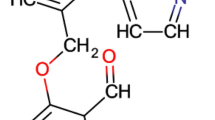Abstract
ERYTHROCYTE sickling and gelation of concentrated solutions of deoxyhaemoglobin (Hb) S (α2β26 Val) results from helical polymerisation of the tetramers, with a spatial orientation approximated by recent ultrastructural and optical studies. Earlier observations of the gelling behaviour of Hb S or Hb C Harlem (α2β26Va1, 73Asn) mixed with Hb A or other haemoglobins gave indirect evidence concerning intertetrameric contact sites, and we proposed that only one β6 valine-determined site was active per tetramer, the other β chain providing different polymer contacts1,2. Our arguments required that asymmetrical hybrids (for example α2βAβS) occurred in Hb mixtures; their long-suspected presence has recently been established3–5, but the dissociation equilibria by which these hybrids form (Fig. 1) hinders their isolation and direct testing of their ability to polymerise. To circumvent this difficulty we have prepared Hb SA hybrids cross-linked intratetramerically to prevent dissociation, and have found them capable of polymer and gel formation quite similar to that of Hb S.
This is a preview of subscription content, access via your institution
Access options
Subscribe to this journal
Receive 51 print issues and online access
$199.00 per year
only $3.90 per issue
Buy this article
- Purchase on Springer Link
- Instant access to full article PDF
Prices may be subject to local taxes which are calculated during checkout
Similar content being viewed by others
References
Bookchin, R. M. & Nagel, R. L. J. molec. Biol. 60, 263–270 (1971).
Bookchin, R. M. & Nagel, R. L. in Sickle Cell Disease, Diagnosis, Management, Education and Research (eds Abramson, Bertles, J. F. & Wethers, D. L.) 140–154 (Mosby, St Louis, 1973).
Bunn, H. F. in Hemoglobin and Red Cell Structure and Function (ed. Brewer, G. J.) 41–53 (Plenum, New York, 1972).
Macleod, R. M. & Hill, R. J. J. biol. Chem. 248, 100–103 (1973).
Park, C. M. Ann. N. Y. Acad. Sci. 209, 237–257 (1973).
Macleod, R. M. & Hill, R. J. J. biol. Chem. 245, 4875–4879 (1970).
Suzuki, T., Benesch, R. E., Yung, S. & Benesch, R. Analyt. Biochem. 55, 249–254 (1973).
Magdoff-Fairchild, B., Poillon, W. N., Li, T. & Bertles, J. F. Proc. natn. Acad. Sci. U.S.A. 73, 990–994 (1976).
Bookchin, R. M. & Nagel, R. L. Semin. Hematol. 11, 577–595 (1974).
Nagel, R. L. & Bookchin, R. M. in Sickle Cell Anemia and Other Hemoglobinopathies (ed. Levere, R. D.) 51–65 (Academic, New York, 1975).
Bookchin, R. M., Nagel, R. L. & Balazs, T. Nature 256, 667–668 (1975).
Goldberg, M. A., Husson, M. A. & Bunn, H. F. J. biol. Chem. 252, 3414–3421 (1977).
Author information
Authors and Affiliations
Rights and permissions
About this article
Cite this article
BOOKCHIN, R., BALAZS, T., NAGEL, R. et al. Polymerisation of haemoglobin SA hybrid tetramers. Nature 269, 526–527 (1977). https://doi.org/10.1038/269526a0
Received:
Accepted:
Published:
Issue Date:
DOI: https://doi.org/10.1038/269526a0
This article is cited by
-
Modification of Axial Fiber Contact Residues Impact Sickle Hemoglobin Polymerization by Perturbing a Network of Coupled Interactions
The Protein Journal (2007)
-
The effects of α chain mutations cis and trans to the β6 mutation on the polymerization of sickle cell haemoglobin
Nature (1982)
-
β-Chain contact sites in the haemoglobin S polymer
Nature (1980)
Comments
By submitting a comment you agree to abide by our Terms and Community Guidelines. If you find something abusive or that does not comply with our terms or guidelines please flag it as inappropriate.



